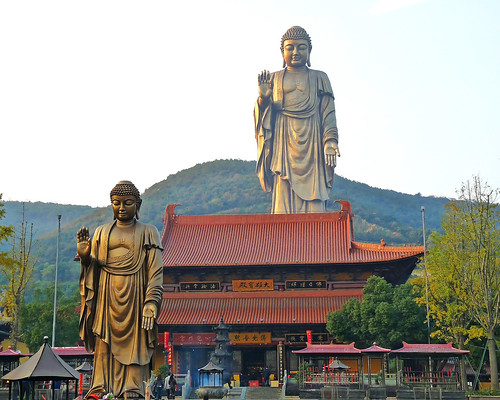Top 5 Things to do to appreciate your Buddhism Travel
I’ve been taking it for granted as a Buddhist and Taoist all the while where I didn’t realise that many of the travelers out there are not. Since most of the Asian countries are Buddhist countries (Thailand, Vietnam,Cambodia, Laos or China), it would be great if travelers of different religion could understand a thing or two about Buddhism, when visiting Asian countries, could really appreciate the beauties of these countries. Most importantly, as a world traveler, could also respect the existence of other religion.

Buddhism is the 4th largest religion in terms of followers and is also one of the oldest religion and philosophy started being taught and introduced in Northern India since 6BC. There are 2 main branches of the religion, namely Theravada (“The School of the Elders”) and Mahayana (“The Great Vehicle”). While the oldest surviving branch of Theravada dominates countries in Southeast Asia especially Indo-China and Thailand, Mahayana Buddhism is widely followed throughout East Asia of China, Taiwan, Hong Kong, Japan and Korea. To recognize between Theravada and Mahayana Buddhism, travelers could easily spot the differences of these 2 branches through their monasteries and statues. Wat are widely seen in Indo-China and Thailand while temples and big Buddha could be found everywhere in mainland China. Nevertheless, the 3rd branches of Buddhism, Vajrayana, which was evolved from Mahayana school of thoughts, could be seen in Tibet, Mongol and Nepal.
There are many religious practices in Buddhism where followers or Buddhists treat them as part of their lives. It would be great if people from other religion could also know and respect these practices. Here are the Top 5 Things travelers could do to fully appreciate and respect the Buddhism countries.
- Do wear appropriate clothing and not to be naked. Especially when you enjoy your holidays in one of those Indo-china tours or Thailand, the local people would be very much appreciate if travelers could respect their religion by not disclosing their bodies in public. Hot pants and sleeveless tops are not recommended in this sense. If you are visiting their temples in short pants and sleeveless shirts, there is always a counter to borrow a cloth to cover up your body, at least.
- Do ‘Wai’ at buddha and in front of temple. You can even ‘Wai’ at monks. ‘Wai’ is a greeting sign among Buddhists by pressing both palms and fingers together as in prayer and bow head and body slightly. By doing this to elderly and monk, you are paying great respect to them. Also not to forget to Wai at temples or wat and also when you see Buddha statues. You won’t miss them if you’re traveling to Indo-China or Thailand.
- Donate for incense and pray for good luck. One of the common religious practice of Buddhists is to do regular devotion to the Buddha. You can do the same in any Chinese temple or Thai wat. Try the devotion practice by donating a small amount of money into the donation boxes (normally 1 or 2USD will do) in the temple, pick up 3 sticks of jossstick or incense, start praying to the Buddha for good luck and then insert them into the dedicated incense bowl.
- Do not photograph with buddha statue. You can always photograph any Buddha statues or temples. I took too many shots at Buddha in Wuxi China also. However, in order to respect the important icon of the religion, don’t photograph with the Buddha (which means pose next to the statue or even hold your hands around him). Always photograph when the Buddha is facing you only, not beside you. This is the basic respect you can pay to the Buddhist.
- Do try the Buddhist cuisine. If you haven’t done so. Buddhist cuisine is known as Zhai Cai (齋菜) among Chinese which is mainly vegetarian. However, some places might allow milk and eggs while some Buddhists don’t treat onion, garlic or leek as vegetarian. There are many Buddhist vegetarian restaurants in China, Hong Kong and Taiwan. Holidays in China must include a vegetarian meal in one of these restaurant. They are not only tasty but also healthy. The main ingredients of Buddhist cuisine include bean curbs, gluten and agar among other vegetables. Vegetarian chefs nowadays could also imitate meat and seafood using these ingredients so perfectly and taste as good.
You would not feel any pain or lose anything by doing the above. Instead, you will feel the serenity in your mind. As a traveler, it would be fun also to do what the local people are doing and to appreciate other religions in this world. However, there is one exception: (Travel Tips) If there are monks approach you in your way and ask for donations in money, ignore them and walk away. They are fake monks. Genuine monks only ask for food, if they ever need donations. If you wish to donate, buy genuine travel blogger(that’s me) a cup of coffee instead… 🙂 – Travel Feeder, the ultimate travel photo blog




Nice post and nice resume of the Buddhist religion. I’d like to add some Japanese perspective to the the points above:
2-In Japan “Wai” would be gassho. Same thing though, clasp you hands together, as if for praying and bow from the hip. Paying respect doesn’t mean you convert to the Buddhist religion, nor is it any other religions. I respect Muslims and Christians even if I am not one.
3- In Japan, you can buy incense bundles, candles and some charms. It is a good idea to light up your offering with a new source of fire (a match or lighter) as in my opinion, taking from someone else’s is like taking from their prayer and adding it to yours.
5- In Japan, this is called Shojin Ryori. In addition to being vegetarian, in includes all five flavors of the Taoist five element theory.
For more details on Buddhism in Japan click here.
- August 10, 2010